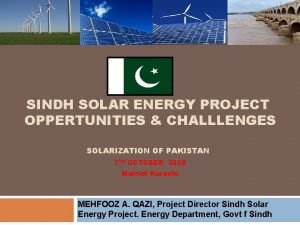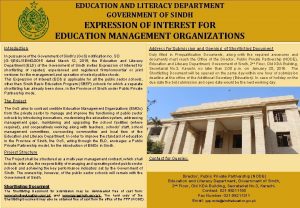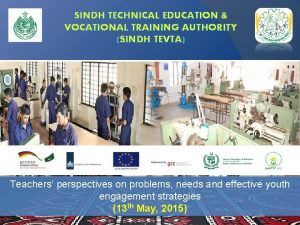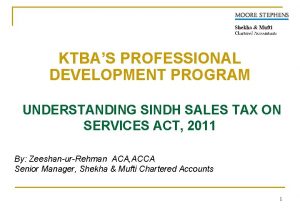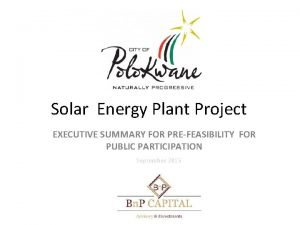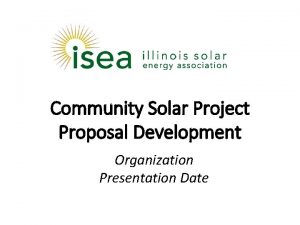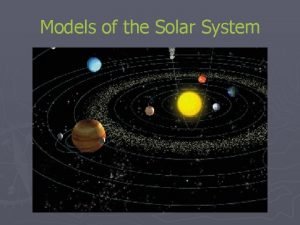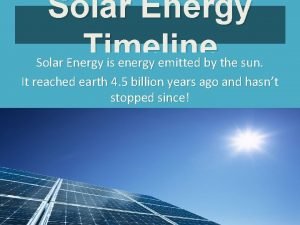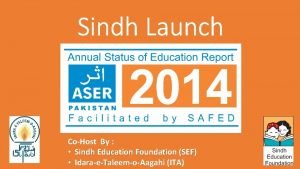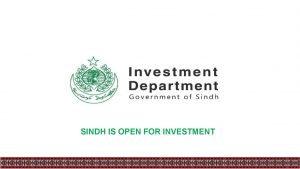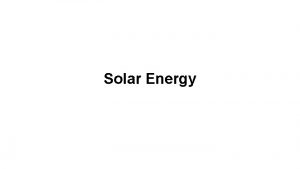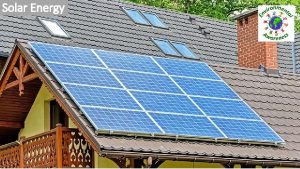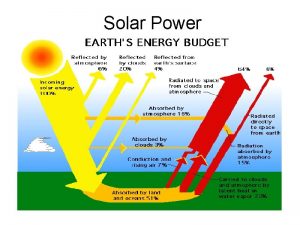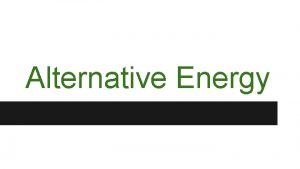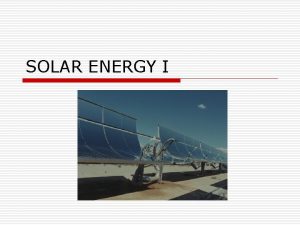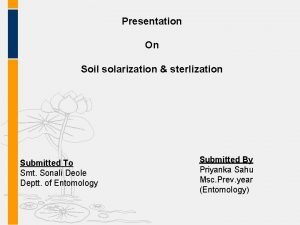SINDH SOLAR ENERGY PROJECT OPPERTUNITIES CHALLLENGES SOLARIZATION OF


















- Slides: 18

SINDH SOLAR ENERGY PROJECT OPPERTUNITIES & CHALLLENGES SOLARIZATION OF PAKISTAN 7 TH OCTOBER 2020 Marriot Karachi MEHFOOZ A. QAZI, Project Director Sindh Solar Energy Project. Energy Department, Govt f Sindh

Sindh –The Energy Hub § § § One of the major reasons for slow economic growth is non-availability of affordable power SINDH – the land of resources; 99% of Pakistan’s total coal reserves 67% of the country’s total natural gas production 38% of Pakistan’s total crude oil production 2 Blessed with only viable Wind corridor

Energy Potential in Sindh Coal Wind Solar Hydro (Low Head) Bagasse Cogen Agro) Waste to Energy MT/D) 185 Billion Tonnes 55000 MW 10 GW(average 5. 5 k. Wh/m 2/day) 130 MW (Run of River) 1000 MW (32 Sugar mills & 500 MW (only Karachi 11, 000 Off Shore Energy Potential, Wind , Tidal Government of Sindh -Vision To make Sindh self sufficient in power generation and export surplus to other provinces by 2020

Average Demand Supply Gap (Power) DISCO Demand Supply Shortfall HESCO 1150 MW 725 MW 425 MW SEPCO 1050 MW 675 MW 375 MW K-Electric 3500 MW 2600 MW 900 MW Total 5700 MW 4000 MW 1700 MW * Source: STDC 4

Share of Clean Energy with low carbon Emissions is 30% (Renewable 5% + Hydel 25% ) Share of Thermal (Oil & Gas) Energy with Carbon Emissions is 66% (IPP , KE and Public Sector)

Fast pace Urbanization has Fast pace Energy Needs

Sustainable Energy for All (SE 4 ALL), a global initiative by UN and a component of Sustainable Development Goals (SDG) , to achieve a sustainable transformation of global energy system for a clean and better future with increased public and private investments in clean energy. The Government of Pakistan joined this SE 4 ALL initiative in 2013. Consequently, the SE 4 ALL Secretariat is coordinating its activities with provincial and federal stakeholders in the country The secretariat has currently developed National Action Plan and Investment Prospectus for SE 4 ALL and expected to be implementing for accelerated deployment of clean energy technologies.

AIMS OF SE 4 ALL & SINDH SOALR PROJECT It aims to achieve following three goals by 2030: Energy Access: increase the universal access to modern energy services such as electricity and clean cooking facilities; Renewable Energy: double the share of renewable energy in the global energy mix; and Energy Efficiency: double the rate of increase in energy efficiency. SSEP Project covers all the above objectives.

WORLD BANK ASSISTANCE SINDH SOLAR ENERGY PROJECT (SSEP) § World Bank funded project (US$ 100 million) for deployment of solar PV technologies • Project Components: 1. Component – 1 – Utility Scale Solar (USD 40 Million) • • II. 400 MW Solar Parks will be developed through Competitive Bidding Hiring of Transactional Advisor first 50 MW Solar Auction at Manjhand, District Jamshoro initiated. Firms have been shortlisted • Component – 2 – Distributed Solar (USD 25 Million) • 20 MW distributed solar power generation facilities will be installed at public sector buildings • The hiring of Consultant to survey of the buildings has been initiated , • By March 2019 , the consultant will be available. III. Component – 3 – Solar Home Systems (USD 30 Million): • • • 200, 000 households will be facilitated with Solar Home Systems in rural areas with low access to electricity. (12 Districts in 1 st phase selected). The hiring of Consultant for House hold survey in rural areas survey of the buildings has been initiated , By March 2019 , the consultant will be available. • IV. Component – 4 – In House Capacity Building (US$ 5 million) • Resource assessment and forecasting center for all RE technologies i-e:

1. Badin Rural Target Districts 2. Sajawal 3. Ghotki 4. Jacobabad 5. Kashmore 6. Khairpur 7. Qambar Shahdadkot 8. Sanghar 9. Tharparkar 10. Umerkot


Proposed Product Range The project aims to provide at least a basic SHS “starter system” to each household, defined in terms of the services provided, as follows: 1 x fan 1 x mobile charging 3 x lights The grant amount per household will be determined on the basis of this starter system, and will be fixed. Larger SHSs with additional features and functionality will also be eligible, but households will get the same grant amount.

SOLAR HYBRID OF JHAMPIR WIND ENERGY FARM (Each strip of 50 MW wind farm is 9 KM long)

Current Scenario- Solar Off – Grid & Net metering All Public Sector Buildings: q q 35 Hospitals with potential of 23 MW at a cost of 12 billion Rupees initiated in round one. Renewable technologies for off-grid application are probably the most profitable and ready for implementation activities. AEDB estimates off-grid applications to have a potential of over 10, 000 MW. q 200 Buildings are expected under this component including : q Solar Schools q Solar Basic Health Units q Solar Water Pumps q Solar Office buildings q Floating Solar Cities) (Water Ponds in Big

The World is Responding Positively to the Call of our New Generation

Why such Accelerated Growth? Cheapest Power Technology Focus on Long Term (Safe, Sustainable, Economical) No Fuel Requirement / No Emissions No Water Requirement No Supply Chain Issues (Ships, Trains, Jetties, terminals, pipelines) Quick installation Mandatory Requirement (e. g. Pledges at COP 21, SDGs)

Government Stance on Clean Energy To increase electricity access, the Governemnt is encouraging investment in generation capacity, distribution systems and in developing indigenous sources of energy. Moreover, scope exists to accelerate electrification to meet growing demand, especially in the rural areas through off-grid solutions In addition to this, Solar electrification and installation of wind energy units in plain areas.

Thank You
 Sindh solar energy project
Sindh solar energy project Define soil solarization
Define soil solarization Solar energy is free. solar is inexhaustible
Solar energy is free. solar is inexhaustible Sindh bureau of statistics
Sindh bureau of statistics Sindh education and literacy department
Sindh education and literacy department Geography of sindh
Geography of sindh Education and literacy department
Education and literacy department Sindh tevta
Sindh tevta Sindh sales tax on renting of immovable property
Sindh sales tax on renting of immovable property Wind energy is an indirect form of
Wind energy is an indirect form of Wholesalesolar com
Wholesalesolar com Energy energy transfer and general energy analysis
Energy energy transfer and general energy analysis Energy energy transfer and general energy analysis
Energy energy transfer and general energy analysis Executive summary for solar project
Executive summary for solar project Solar project proposal doc
Solar project proposal doc Solar village project
Solar village project Aristarchus model
Aristarchus model Timeline of solar energy
Timeline of solar energy Solar energy syllabus
Solar energy syllabus
